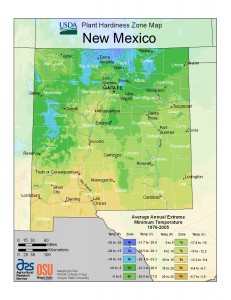The U.S. Department of Agriculture (USDA) released an updated version of its Plant Hardiness Zone Map. The previous map, published in 1990, determined zones using weather data for 1974 through 1986. The new map analyzed 30 years of data, 1976-2005, to determine more accurate average minimum temperatures across the country.
This tool, jointly developed by USDA’s Agricultural Research Services and Oregon State University’s PRISM Climate Group, provides greater accuracy and detail than the 1990 version. It is now available online: http://planthardiness.ars.usda.gov/. The new Internet-friendly map offers a Geographic Information System (GIS)-based interactive format. The map website also incorporates a “find your zone by ZIP code” function.
The new version of the map includes 13 zones, with the addition for the first time of zones 12 (50-60 degrees Fahrenheit) and 13 (60-70 degrees Fahrenheit). Each zone is a 10-degree Fahrenheit band, further divided into 5-degree Fahrenheit zones “A” and “B.”
We tested this new tool and determined Santa Fe has changed slightly and is now officially in 6b (-5 to 0 degrees Fahrenheit).
Upon close examination, our nearby mountainous region appears to straddle two zones, 6a and 6b, and if you live in the foothills at higher elevation then you may be closer to 6a. Santa Fe was formerly in climate zone 5 and as a result of this new map, our zone has changed and due to data reflecting the minimum temperatures are not as cold on average.
David Salman, President and Chief Horticulturist at Santa Fe Greenhouses/High Country Gardens, points out further, “Over the past thirty years that I have been gardening in SF, I have definitely seen the winters becoming warmer and the range of plants we are able to grow here has expanded as a result.”
The 2012 USDA Plant Hardiness Zone Map is the standard by which gardeners and growers can determine which plants are most likely to thrive at a location.
Anyone may download the map free of charge from the Internet onto their personal computer and print copies of the map as needed.
To read the full press release on the new Plant Hardiness Zone Map, click here.



